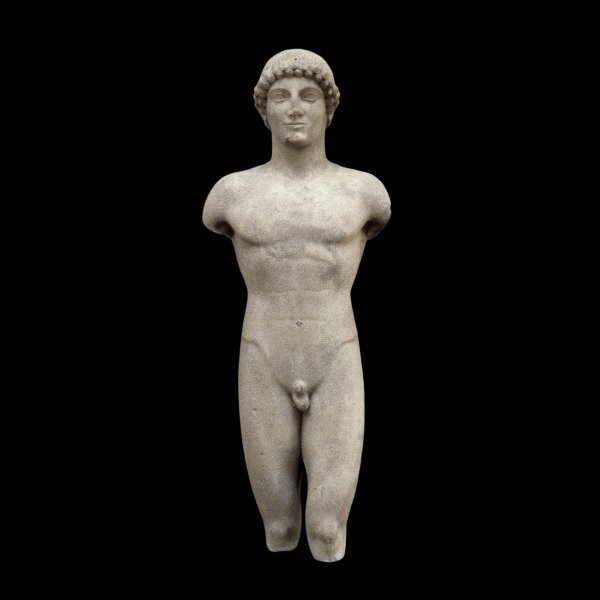The Strangford Apollo
Dublin Core
Title
The Strangford Apollo
Subject
Archaic Greek art
Description
The Strangford Apollo
Greek, about 500-490 BC
Said to be from the island of Anáfi, Cyclades, Aegean Sea
Marble statue of a youth standing in the conventional pose of a kouros
Kouros in Greek means simply 'youth'. It is a term used to describe a type of statue of a male figure produced in marble during the Archaic period of Greek art (about 600-480 BC). Such statues can be colossal (that is larger than life) or less than life size. They all have a conventional pose, where the head and body can be divided equally by a central line, and the legs are parted with the weight placed equally front and back.
The mouth is invariably fixed in a smile, which is probably a symbolic expression of the arete ('excellence') of the person represented. It used to be thought that all kouroi were intended as representations of the god Apollo. However, although some may be intended as representations of gods or heroes, many were simply grave markers. The kouros was not intended as a realistic portrait of the deceased, but an idealized representation of values and virtues to which the dead laid claim: youthful beauty, athleticism and aristocratic bearing, among others.
This less than life-sized statue (about 1 metre tall) was carved towards the end of the Archaic period, when the conventional smile was replaced by a solemn pout, the facial expression of classical sculpture. There is still a hint of a smile here, and this youth wears his hair long in the archaic manner, braided around the back and in a formal arrangement of curls at the front.
The figure is known as the Strangford Apollo after a previous owner, the sixth Viscount Strangford.
G.M.A. Richter, Kouroi: Archaic Greek youths, 3rd ed. (London and New York, Phaidon, 1970)
Greek, about 500-490 BC
Said to be from the island of Anáfi, Cyclades, Aegean Sea
Marble statue of a youth standing in the conventional pose of a kouros
Kouros in Greek means simply 'youth'. It is a term used to describe a type of statue of a male figure produced in marble during the Archaic period of Greek art (about 600-480 BC). Such statues can be colossal (that is larger than life) or less than life size. They all have a conventional pose, where the head and body can be divided equally by a central line, and the legs are parted with the weight placed equally front and back.
The mouth is invariably fixed in a smile, which is probably a symbolic expression of the arete ('excellence') of the person represented. It used to be thought that all kouroi were intended as representations of the god Apollo. However, although some may be intended as representations of gods or heroes, many were simply grave markers. The kouros was not intended as a realistic portrait of the deceased, but an idealized representation of values and virtues to which the dead laid claim: youthful beauty, athleticism and aristocratic bearing, among others.
This less than life-sized statue (about 1 metre tall) was carved towards the end of the Archaic period, when the conventional smile was replaced by a solemn pout, the facial expression of classical sculpture. There is still a hint of a smile here, and this youth wears his hair long in the archaic manner, braided around the back and in a formal arrangement of curls at the front.
The figure is known as the Strangford Apollo after a previous owner, the sixth Viscount Strangford.
G.M.A. Richter, Kouroi: Archaic Greek youths, 3rd ed. (London and New York, Phaidon, 1970)
Publisher
The British Museum
Rights
© Trustees of the British Museum
Format
Height: 101.000 cm
Citation
“The Strangford Apollo,” Hallie Ford Museum of Art Exhibits, accessed December 25, 2025, https://library.willamette.edu/hfma/omeka/items/show/20.
